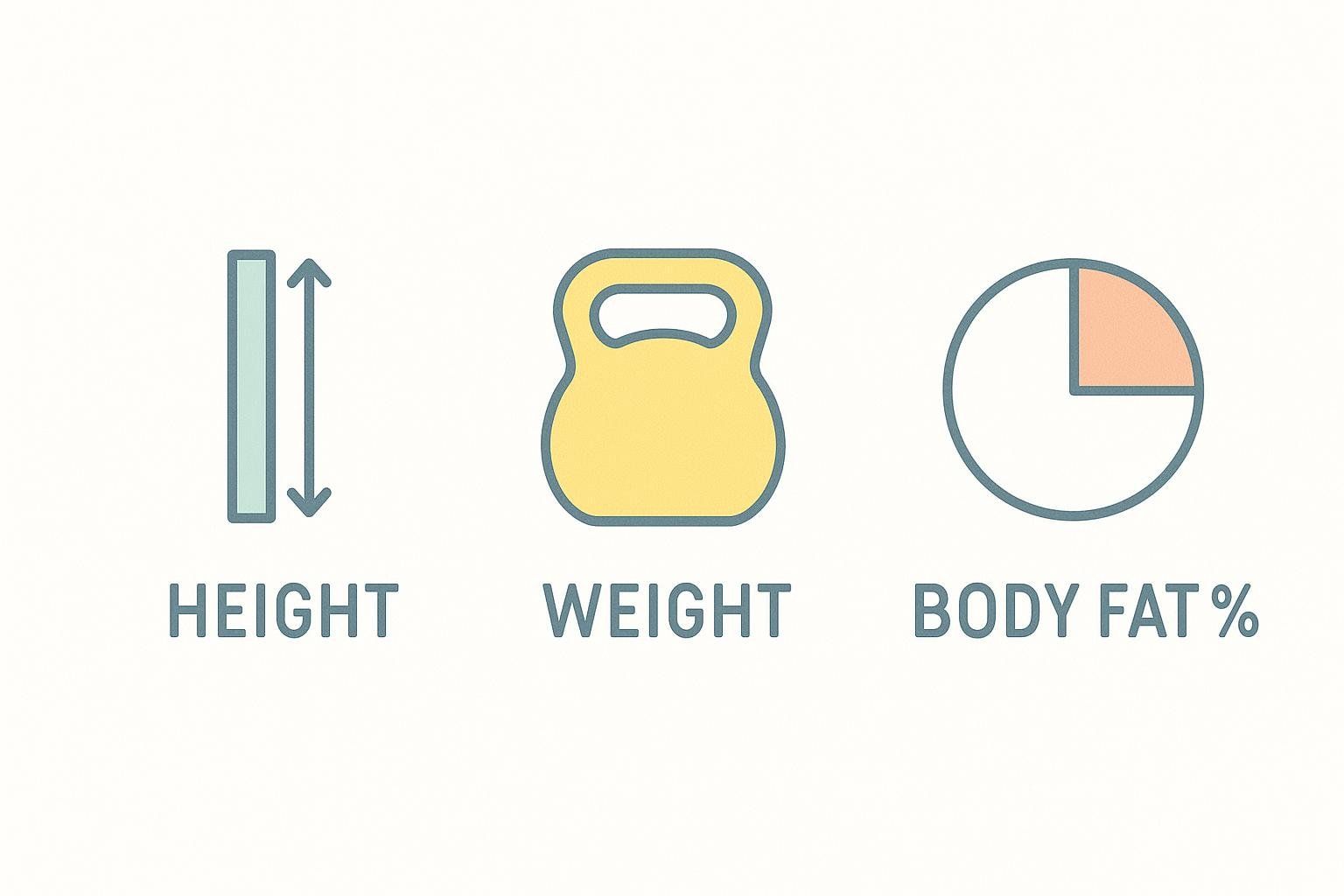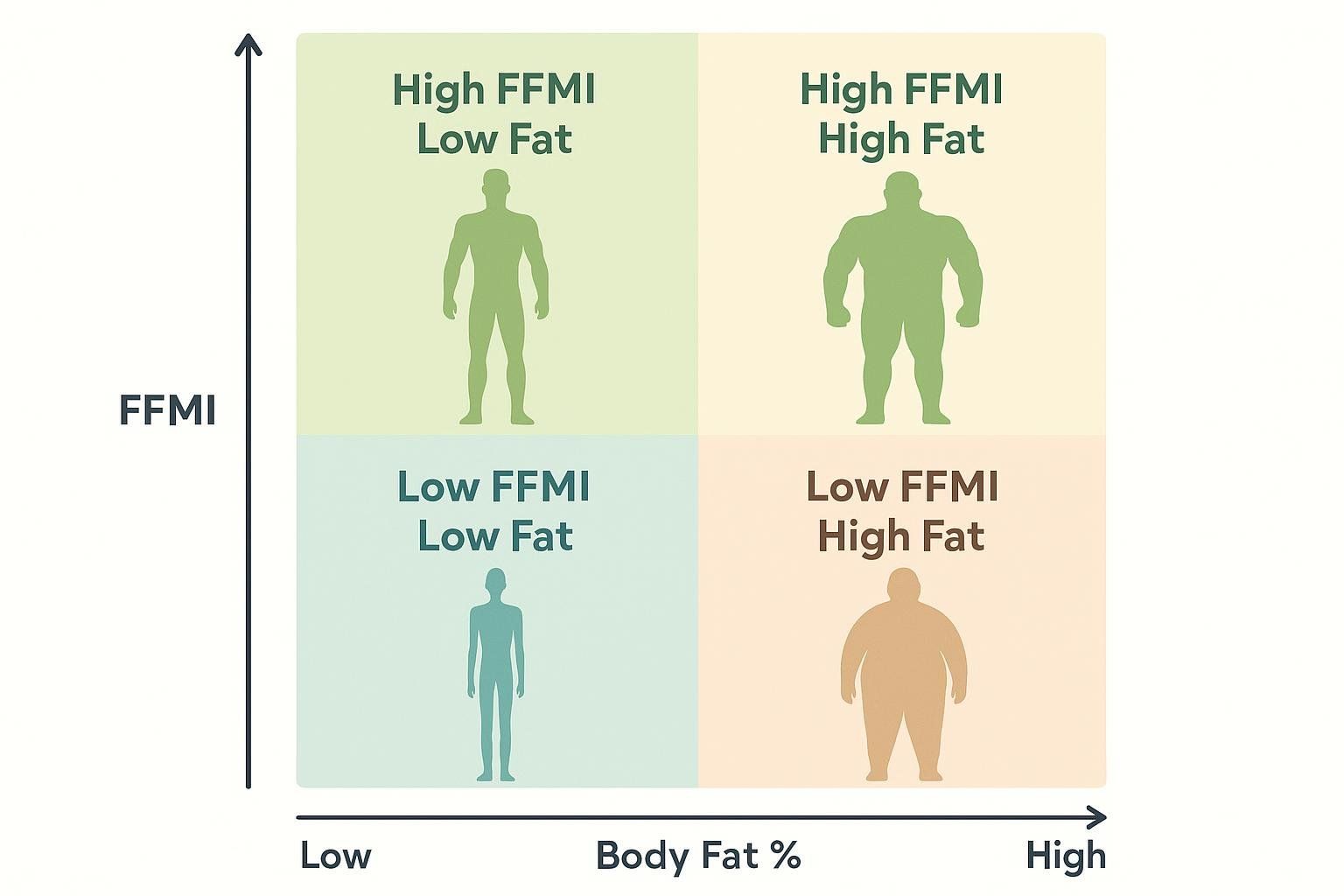FFMI Calculator: Reaching Your Natural Muscle-Building Potential

FFMI Calculator: Are You Reaching Your Natural Muscle-Building Potential?
If you've been training consistently and building muscle, your Fat-Free Mass Index (FFMI) provides far more meaningful insights than BMI or standard weight measurements. FFMI measures your muscle mass relative to your height, unlike BMI which treats all weight equally whether it's muscle, fat, or bone.
It's the gold standard for evaluating muscular development. It also serves as a benchmark for assessing whether a physique is achievable naturally, based on research into the limits of drug-free athletes.
Whether you're a dedicated lifter wondering if you're approaching your genetic potential, someone trying to preserve muscle during fat loss, or simply curious about where your physique stacks up against elite natural athletes, this comprehensive guide will give you the tools and insights you need.
Interactive FFMI Calculator
To calculate your FFMI, you'll need three key measurements:

- Height (feet/inches or centimeters)
- Body weight (pounds or kilograms)
- Body fat percentage (as accurate as possible)
The calculator will provide both your standard FFMI and normalized FFMI (adjusted to average height), along with interpretations for your specific score.
Don't know your body fat percentage? For the most accurate FFMI calculation, consider getting a DEXA scan, which provides precise body composition measurements with an error margin as low as 1-2%. If you need help determining your body fat percentage using other methods, check out our comprehensive guide on how to calculate body fat percentage.
What is Fat-Free Mass Index (FFMI)?
Fat-Free Mass Index provides a more sophisticated body composition metric than BMI by specifically measuring muscle mass relative to height. In contrast to BMI's simplistic weight-to-height ratio, FFMI separates muscle tissue from fat and bone to provide meaningful insights into your muscular development.
Here's the basic breakdown:
Fat-Free Mass = Total Body Weight - Fat Mass
FFMI = Fat-Free Mass (kg) ÷ Height² (meters)
But there's a crucial refinement called normalized FFMI, which adjusts your score to account for height differences. This matters because taller individuals can naturally carry more mass, which would otherwise inflate their unadjusted FFMI score.
Normalized FFMI = FFMI + 6.3 × (1.8 - Height in meters)
The normalization formula, developed by Kouri et al. in 1995, adjusts everyone's FFMI to what it would be if they were 1.8 meters (about 5'11") tall. This creates a level playing field for comparing individuals of different heights, regardless of their natural stature.
How to Calculate FFMI: Step-by-Step
Let's walk through a real example to make this crystal clear.
Example: Male, 180 lbs, 5'10", 15% body fat
Step 1: Calculate Fat-Free Mass
- Total weight: 180 lbs (81.6 kg)
- Body fat: 15%
- Fat mass: 180 × 0.15 = 27 lbs (12.2 kg)
- Fat-free mass: 180 - 27 = 153 lbs (69.4 kg)
Step 2: Calculate Standard FFMI
- Height: 5'10" = 1.78 meters
- FFMI = 69.4 ÷ (1.78)² = 69.4 ÷ 3.17 = 21.9
Step 3: Calculate Normalized FFMI
- Normalized FFMI = 21.9 + 6.3 × (1.8 - 1.78) = 21.9 + 0.126 ≈ 22.0
This individual has a normalized FFMI of 22.0, which places them in the "Excellent" category—on the cusp of the Elite natural level and well within natural limits.
FFMI Score Interpretation: What Your Numbers Mean
Understanding your FFMI score depends significantly on your biological sex, as men and women have different muscle mass potentials due to hormonal differences. These classifications serve as general guidelines to help interpret your score based on observations of drug-free athletes.
While the male ranges are based on the foundational Kouri et al. study, the female ranges are adapted from male data and limited observational studies, making them less definitive.
| FFMI Score | Interpretation for Men | Interpretation for Women |
|---|---|---|
| 14-16 | Below average (sedentary) | Below average (sedentary) |
| 16-18 | Average (new to training) | Average (new to training) |
| 18-20 | Good (some training, 1-2 years) | Good (consistent training, 2-3 years) |
| 20-22 | Excellent (consistent training, 2-4 years) | Excellent (advanced training, 4+ years) |
| 22-24 | Elite natural level (4+ years) | Elite natural level (exceptional genetics) |
| 24-25 | Exceptional natural level (near genetic potential) | Exceptional; may approach upper natural limits |
| 25+ | Likely enhanced or exceptional outlier | Likely enhanced or exceptional outlier |
Female FFMI upper limits are estimates based on limited research and individual cases may vary significantly.
The Science Behind FFMI and the Natural Limit
The foundation of FFMI research rests on the landmark 1995 study by Kouri et al., which examined 157 male athletes and established the controversial "natural limit" of 25 FFMI for men. Here's what the research actually reveals:

Original Kouri Study Findings
Using the normalization formula previously discussed, the study found:
- 74 natural athletes: Normalized FFMI range 16.6-25.0
- 83 steroid users: Many exceeded FFMI of 25, with some reaching 30+
- Analysis of pre-steroid era Mr. America winners (1939-1959) revealed an average FFMI of 25.4, representing a likely peak of natural human potential
- Key conclusion: FFMI > 25 strongly suggests steroid use
The 25 FFMI "Natural Limit" Controversy
While the 25 FFMI threshold has become widely cited as the natural ceiling, modern analysis suggests this limit might be overly conservative for some individuals with exceptional genetics.
Evidence supporting the 25 limit:
- No natural athlete in the original study exceeded this threshold
- Consistent replication in subsequent research
- Strong correlation with known steroid use above this level
Evidence questioning the absolute limit:
- Some documented natural athletes have achieved FFMI scores slightly above 25
- Genetic variations in muscle fiber distribution and hormonal profiles
- Improvements in training methodology and nutritional science since 1995
Current scientific consensus: While FFMI > 25 strongly suggests enhancement, achieving 24-25 naturally is possible but requires exceptional genetics, years of optimal training, and very low body fat levels.
FFMI vs Other Body Composition Metrics
FFMI vs. BMI
BMI has a notorious blind spot: it can't differentiate between muscle and fat. A bodybuilder and a couch potato could have identical BMI scores despite vastly different health profiles.
Consider this comparison:
-
Elite natural bodybuilder: 185 lbs, 5'10", 8% body fat
- BMI: 26.5 (classified as "overweight")
- FFMI: 24.8 (elite natural level)
-
Sedentary individual: 180 lbs, 5'10", 30% body fat
- BMI: 25.8 (also classified as "overweight")
- FFMI: 17.3 (below average, sedentary level)
FFMI reveals the crucial distinction that BMI completely misses.
FFMI vs. Body Fat Percentage
While body fat percentage tells you about your leanness, FFMI reveals your muscularity. Both metrics together paint a complete picture:

- High FFMI + Low body fat = Elite physique
- Low FFMI + Low body fat = Lean but with low muscle mass
- High FFMI + High body fat = Strong but less defined
- Low FFMI + High body fat = Indicates need to focus on resistance training
FFMI Limitations and Considerations
While FFMI is a powerful tool, understanding its limitations is crucial for proper interpretation and application.
Body Fat Measurement Accuracy Issues
Your FFMI is only as accurate as your body fat measurement, and most methods have significant error margins:
- Bioimpedance scales: ±5-8% error
- Skinfold calipers: ±3-5% error (highly technique-dependent)
- BodPod: ±2-3% error
- DEXA scans: ±1-2% error
A 5% error in body fat measurement can swing your FFMI by 2-3 points, potentially changing your classification from "natural elite" to "likely enhanced."
Individual Genetic Variations

Muscle Fiber Distribution
Individuals with higher fast-twitch muscle fiber ratios may naturally achieve higher FFMI scores due to greater hypertrophy potential.
Bone Structure
People with larger frames can typically support more muscle mass, potentially achieving higher natural FFMI scores than those with smaller frames.
Hormonal Profiles
Natural testosterone levels, growth hormone production, insulin sensitivity, and myostatin expression all influence muscle-building capacity and can create significant individual variation.
Situational Limitations
Training Experience Effects
Early training adaptations include increased glycogen storage and improved muscle hydration, which can temporarily inflate FFMI measurements in beginners.
Extreme Height Variations
Very tall (>6'4") or short (<5'4") individuals may not fit normalized FFMI models well, as the 1.8-meter normalization was based on average-height populations.
Age Considerations
Muscle mass naturally declines with age starting around 30, so it's worth considering age when interpreting FFMI scores—for example, an FFMI of 22 is more exceptional for a 60-year-old than a 25-year-old.
Measurement Timing
Factors like hydration status, recent training, and carbohydrate intake can affect body composition measurements and therefore FFMI calculations.
Using FFMI for Your Fitness Goals
Tracking Muscle-Preserving Fat Loss
FFMI shines during cutting phases because it separates muscle preservation from fat loss. Here's how to use it effectively:
Scenario: You want to lose 20 lbs of fat while maintaining muscle
- Track both body weight and body fat percentage
- Calculate FFMI at regular intervals (every 6-8 weeks for DEXA scans, or more frequently with less precise methods)
- Goal: Maintain or slightly increase FFMI while decreasing total weight
If your FFMI drops significantly during a cut, it indicates muscle loss—time to adjust your approach with higher protein intake, resistance training volume, or a more moderate calorie deficit.
Setting Realistic Muscle Gain Expectations
FFMI provides a reality check for muscle-building goals. Achieving an FFMI above 23 (for men) typically requires:
- 3-5 years of consistent training
- A combination of excellent genetics and exceptional work ethic
- Single-digit body fat for peak FFMI expression
Realistic Muscle Gain Rates
Widely-cited models from author Lyle McDonald suggest achievable muscle gain rates vary by training experience:
| Experience Level | Projected Monthly Muscle Gain |
|---|---|
| Beginners (first year) | 1-2% of body weight |
| Intermediate (1-3 years) | 0.5-1% of body weight |
| Advanced (3+ years) | 0.25-0.5% of body weight |
These muscle gain rates translate directly into FFMI improvements over time, with beginners seeing faster increases and advanced trainees requiring years of consistent effort for meaningful FFMI improvements.
When to Get a DEXA Scan for Accurate FFMI
For serious FFMI tracking, body fat accuracy is paramount. Consider a DEXA scan if you're:
- Approaching advanced FFMI levels (22+ for men, 19+ for women)
- Competing or seriously considering competition
- Using FFMI to guide training periodization
- Curious about your true natural potential
DEXA scans provide precise body composition measurements including visceral fat assessment, bone density, and regional muscle distribution—all valuable data beyond just FFMI calculation.
Maximizing Your Natural FFMI Potential
Based on research from sports science and strength training literature, here are evidence-backed strategies for optimizing your natural muscle-building potential:
Training Fundamentals

- Progressive Overload: Consistently increase weight, reps, or sets over time—this principle is fundamental to muscle adaptation
- Compound Movements: Focus on squats, deadlifts, bench press, and rows for maximum muscle activation
- Volume: Research supports 10-20 hard sets per muscle group weekly for optimal growth
- Frequency: Training each muscle group 2-3 times per week is supported by research for optimizing muscle protein synthesis
Nutritional Optimization

- Protein: Research shows 0.7-1g per pound of body weight daily is optimal, supported by muscle protein synthesis studies
- Calorie Surplus: 200-500 calories above maintenance for muscle gain without excessive fat accumulation
- Meal Timing: Total daily protein is key, but distributing it every 3-4 hours can help maintain amino acid availability for muscle growth
- Hydration: Adequate water intake supports muscle protein synthesis and training performance
Recovery and Lifestyle

- Sleep: 7-9 hours nightly for optimal hormone production, particularly growth hormone and testosterone
- Stress Management: Chronic stress elevates cortisol, which impairs muscle growth and recovery
- Consistency: Small daily actions compound over months and years
Supplementation
- Supplementing with Creatine Monohydrate (3-5g daily) is a well-researched way to boost strength and power gains
- Choosing the right protein shake offers a convenient way to meet protein targets with high bioavailability
- Supplementing with Vitamin D is often necessary as it's commonly deficient and crucial for hormone production and muscle function
Beyond the Numbers: FFMI as a Tool, Not a Destination
Remember that FFMI is a tool for guiding progress, not the ultimate goal. The real objective is building a strong, healthy, functional physique that serves your life goals.
Use FFMI as:
- A reality check for setting appropriate expectations
- A progress tracker during body recomposition phases
- A conversation starter about natural vs. enhanced physiques
- A complement to other health metrics like cardiovascular fitness and metabolic health
Don't let it become:
- An obsession that overshadows training enjoyment
- A comparison tool that breeds insecurity or superiority
- A substitute for focusing on performance, health, and wellbeing
Conclusion: Your FFMI Journey Starts Now
Your Fat-Free Mass Index provides a superior way to measure muscular development, offering far more insight than a standard scale or BMI chart. Whether you discovered you're already operating at elite natural levels or you've identified room for growth, the key is using this information to optimize your approach.
To get started, calculate your current FFMI using the most accurate body fat measurement available, then set realistic goals based on your training experience and genetics. Remember that the highest FFMI scores come from years of consistent effort, not quick fixes or shortcuts, and focus on the fundamentals: progressive training, adequate nutrition, and quality recovery.
For the most precise FFMI tracking, consider booking a DEXA scan at BodySpec. Our advanced body composition analysis provides the accuracy you need to make informed decisions about your training and nutrition. Your genetic potential is waiting to be unlocked—now you have the tools to measure the journey.


